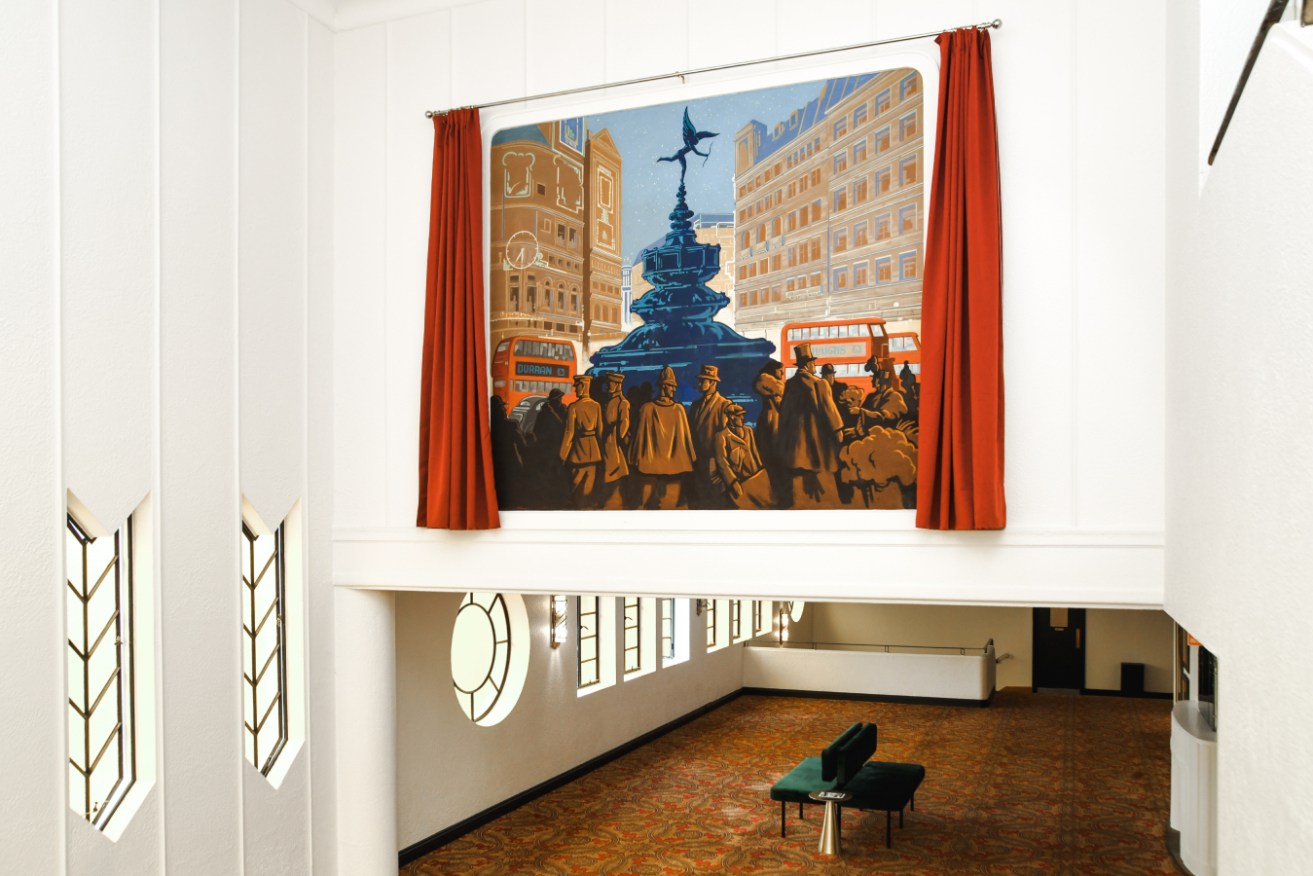Historic Piccadilly Cinema mural uncovered after 60 years
A mural boarded up since the 1960s has been painstakingly uncovered and brought back to life in the foyer of the Piccadilly Cinema, in a nod to the building’s rich history.


Extensive restoration work has returned the enormous Piccadilly Circus mural to its former glory. Photo Jack Fenby / InReview.
The mural, which depicts Piccadilly Circus in London, was painted in 1940 by local artist Frank Hussey and is a reproduction of The Piccadilly Circus by renowned English-Australian artist F Millward Grey.
When the mural was first unveiled at the cinema’s grand opening in the 1940s, The News reported that the 3m by 2.7m (10ft by 9ft) picture gave “a striking effect to the foyer”.
“It shows London’s buses and crowds thronging the world-famous thoroughfare, with the statue of Eros in the centre of the circus, dominating the scene,” it noted.
The mural remained untouched until Greater Union bought the North Adelaide cinema in the 1960s, renaming it The Forum and altering several original features. Hussey’s painting was unceremoniously covered up with a wooden panel featuring a printed image of a Roman forum. The wooden panel was fixed to the wall by drilling into the mural itself.
It stayed that way, hidden from the milling cinema crowds, for more than 60 years.

This image shows the wooden panel (featuring a Roman Forum) being painstakingly removed to reveal the mural beneath. Photo supplied.
Then last year the Wallis family, which bought the iconic cinema in 1983, began extensive renovation work on the Piccadilly. Restoring the historic artwork – which evokes the old-time grandeur of a night out at the cinema – was a key part of the process.
Today, Piccadilly promotional officer Macintyre Howie Reeves says the mural depicts the exciting hustle and bustle of the time, with “dressed-up figures and great architecture”.
“It displays Clifford’s original vision of wanting the Piccadilly to be a hub for Adelaide, as a place that people could converse, explore ideas and see great films,” he says.
However, it became clear early on in the restoration process that returning the mural to its former glory would need professional restoration expertise.
“Although the majesty of the original image was still intact, it was clear that the mural needed restoration work due to the ravages of time and the damaging process which was employed to cover up the work,” Howie Reeves says.
“There were some fine cracks throughout the piece, some pieces of the framing missing and some structural damage. The picture was clear and fairly well-preserved but it definitely needed professional restoration.”
A team at Artlab, led by principal conservator of paintings Eugene Taddeo, was brought in, with support from the Heritage Incentive Scheme, to assess and advise on the unique job.
“We have worked on historic painted interiors and other murals in the past, but this mural was an exciting find because I believe for many years its existence was in question,” Taddeo says.
He and his restoration team of Dr Maria Kubik and Chris Payne began the meticulous and painstaking work in February this year, balancing on scaffolding for the three-week duration. The challenge was to stabilise the structural damage first, to allow restoration and cleaning work to begin.

The damage to the historic mural, including cracks and fading paint, was obvious once it was fully uncovered. Photo supplied.
The Artlab team worked in collaboration with Andrew Steinkopf, of Building Conservation Technology, who removed the embedded metal fixings, then injected adhesives to stabilise drummy plaster.
“While most of the wooden battens holding the panel to the mural had been removed as part of the renovation of the cinema, there were numerous metal fixings which held the battens that were still embedded in the mural,” Taddeo says. “It was clear that their removal would require careful planning to avoid further damage.
“During that initial examination, we noted several areas of loss and areas of delaminating plaster and paint which was very fragile and had the potential to fall off. A network of fine cracks traversed the mural, and paint was lifting along some of these cracks.

The restoration was meticulous work for the Artlab team. Photo supplied
“The mural was also covered in a film of grime, dulling the original colours beneath. Small test cleans indicated there would be a substantial improvement in the appearance of the mural once this film was removed.”
As the important work unfolded, the mural’s original vibrant colours gradually began to resurface. This then allowed for plaster and paint losses to be filled and retouched to match.
“We used such colours as French Ultramarine, Cobalt Blue, Yellow Ochre and Raw Umber, which are all professional artist, water-based paints that could be removed if required at a later date, because as a conservator we are ethically bound to use materials made to be reversible where possible and that can be easily differentiated from the original,” Taddeo says.
Howie Reeves says restoring “Piccadilly Circus” – which was officially unveiled this week – was the Wallis family’s way of honouring “this significant piece of South Australian art which deserves to be on display”.
“It’s also a part of the Piccadilly’s history,” he says. “The Wallis family has an exceptional love for the building and the mural is a core part of the building – as significant as the windows and the façade, which so many Australians know and love.
“It brings a sense of wonder at the history of the building. It’s very unique to see this sort of art work in a building that isn’t an art gallery or a hub for historical pieces.
“It still has a great connection to its past and the Adelaide of the ’40s, but it’s at a venue that people still attend the way that they used to, in slightly less fancy clothes! It feels like it’s a living work.”

The finished mural pops with colour and action. Photo Jack Fenby / InReview.




